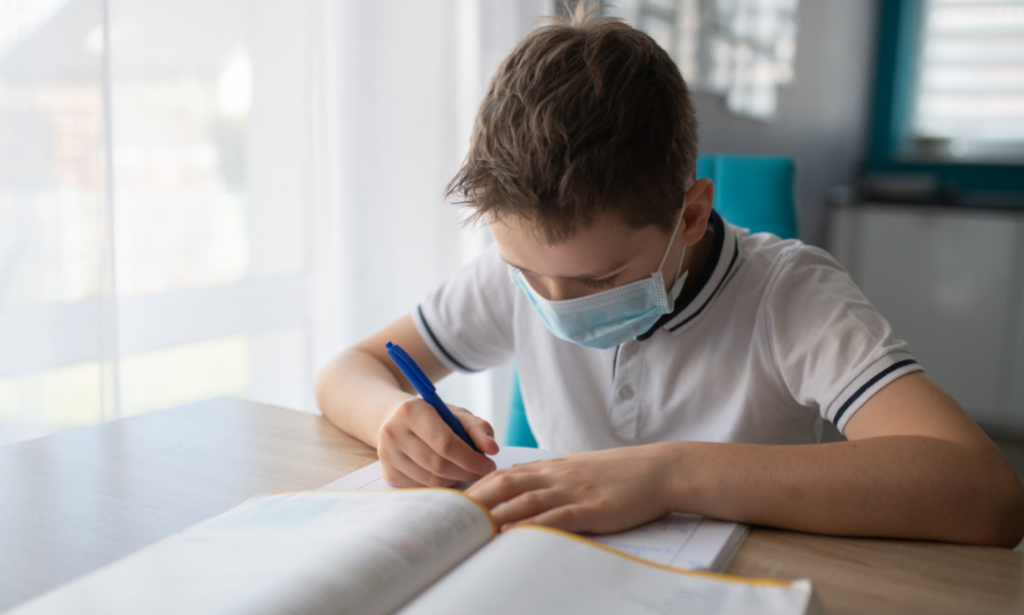Here we are again. Just when we thought COVID-19 was behind us, it’s back with a vengeance. The Delta variant has proven to be highly contagious, and new variants are most likely not far behind. So, as we try to enjoy the remaining days of summer, that question once again wreaks havoc on our minds…what is school going to look like in the fall and beyond? Not to mention other questions such as:
Will there be more closures?
More remote learning?
More hybrid education?
And now, what is school going to look like from this point on?
School uncertainty, unfortunately, is still very much a part of our lives. And children of all ages are feeling it.
It’s now been a year and a half of uncertainty and stress, with children (and adults) understandably worried and frustrated about where school will be held, whether masks will be required, whether COVID-19 might infect them or someone they love. These are grim thoughts for kids of any age…but it’s the sad reality, and it has a mental–and possibly even a physical–impact now and down the road.
Uncertainty As a Source of Stress in Childhood
Uncertainty, as a whole, is a known stressor that can lead to several types of disorders. More specifically, the unknown surrounding school is a major source of anxiety and apprehension for students, teachers, parents, administrators…everyone, really. The primary concern, next to physical health of course, is the overall mental well-being of students. There is evidence this anxiety around school is profoundly impacting students, from kindergarten all the way through college.
Did you know that during the beginning stages of COVID last spring, according to a survey conducted in 2020 by America’s Promise Alliance, more than 25% of children and young adults (ages 13 to 19) reported an increase in lost sleep because of worry, unhappiness, depression, and stress? From April to October of 2020, there was an increase of 24% (ages 5 to 11) and 31% (ages 12 to 17) in emergency room visits for mental health reasons, according to the Centers for Disease Control and Prevention (CDC).
Additionally, further studies have shown that “early childhood may be a particularly sensitive time in which stressful life events–such as those related to trauma or poverty–can calibrate the brain’s stress-response system, with health consequences that last into adulthood” and that childhood stress may physiologically change the structure and shape of the brain.
It’s no secret that children who experience trauma are more susceptible to mental disorders such as anxiety, depression, post-traumatic stress disorder (PTSD), suicide, and substance abuse, as well as physical health issues like sleep difficulty, a weakened immune system, and an increased risk of illness throughout adulthood.
Unfortunately, many kids have experienced quite a bit of trauma since the spring of 2020, whether in the form of illness or death of a loved one or isolation from friends and family–the risk of which increased greatly during COVID-19 due to factors such as job loss, financial hardships, and strained relationships. In fact, the pandemic exponentially increased risk factors as well as actual negative outcomes associated with mental well-being.
When Is It Too Little, Too Late?
As you experienced by early in the 2021 calendar year, many schools opened completely for full-time in-person learning–those that hadn’t followed shortly thereafter. Some schools completely lifted their mask requirements. COVID was OVER!
Except it wasn’t. It never really left, actually. Sadly, COVID-19 is, and always will be, a defining event in the lives of everyone on the planet. The pandemic has already taken its toll–both physically and mentally–on the human race, and the stark reality is the aftereffects will last a lifetime.
So, how do current students move on during the 2021-22 school year?
At this moment, just over half (51%) of the U.S. population (who is eligible) is fully vaccinated against COVID-19. Though we’ve seen many instances of people still contracting the virus despite being fully vaccinated, data has consistently shown the hospitalization and death rates of those infected after vaccination are a fraction of the rates than the unvaccinated.
Of course, this doesn’t necessarily help children under the age of 12, who are not yet eligible for a vaccination. Or those who voluntarily decide against being vaccinated. And the Delta variant is more easily transmissible among children, which has caused child hospitalization rates to explode.
All of this will make a larger impact on families as states and school districts determine how to proceed for the 2021-22 school year. On August 5, the CDC updated their school guidelines to state: “CDC recommends universal indoor masking for all teachers, staff, students, and visitors to K-12 schools, regardless of vaccination status. Children should return to full-time in-person learning in the fall with layered prevention strategies in place.”
While most, if not all, areas of the country plan for 100% in-person learning this fall, the reality is that no one can know for sure what the future holds. The CDC isn’t (yet) recommending school closures or hybrid learning, but is escalating its mask and vaccination recommendations.Could this be the first step on the path toward school shutdowns or remote learning? Hopefully not, but it’s a distinct possibility we all know too well. And that’s part of the problem…more uncertainty!
The bottom line is, there will be unhappy parents and kids regardless of what decisions are implemented. One thing is for sure, however…no one should have to be forced onto the education-driven emotional rollercoaster again, the stress of not knowing what the following week will look like for school. This will once again take its toll on children, no matter their age. The constant yo-yo effect is a damaging one for students who need stability and consistency in order to not only succeed but live better.
It Is Up to Us to Remove the Uncertainty
Families can, however, find stability and consistency when it comes to school–through homeschooling. As many now have experienced first-hand, homeschooling is a way of life full of possibilities…not closed doors. We’ve mentioned before how, even during the worst times of a global crisis such as COVID-19, homeschool students were remarkably unaffected by educational inconsistencies. Of course, homeschooled students had to deal with all the other stresses and consequences that the pandemic forced upon us, but one less major worry (school) removes another major stressor (uncertainty) from students and parents alike.
It’s one of the many reasons parents not only had positive opinions about homeschooling throughout COVID, but why an increasing number of families are considering homeschooling on a permanent basis.
In a world mired in uncertainty, homeschooling offers a modicum of consistency.
- Students know from day to day where they’ll be learning, how they’ll be learning, and what they’ll be learning.
- There’s no distress around wearing a mask or not.
- There’s no fear of contagion in a crowded classroom or on a school bus.
- There’s no loss of learning due to constant disruptions.
- And there is no worry that, in the blink of an eye, school might be closed the next day.
Homeschooling, whether you choose live classes online or opt for another program, is a foundation of normalcy families can rely on and, better yet, build upon. More than anything these days, isn’t a sense of consistency exactly what the doctor would order for children’s well-being?
If you’re considering a switch to homeschooling or are looking to continue, Bridgeway Academy is an award-winning choice made by thousands of families for over three decades.
Call us today at (800) 863-1474 today to learn more about what Bridgeway Academy has to offer.
Source:
1Wu D, Yu L, Yang T, Cottrell R, Peng S, Guo W and Jiang S (2020) The Impacts of Uncertainty Stress on Mental Disorders of Chinese College Students: Evidence From a Nationwide Study. Front. Psychol. 11:243. doi: 10.3389/fpsyg.2020.00243







